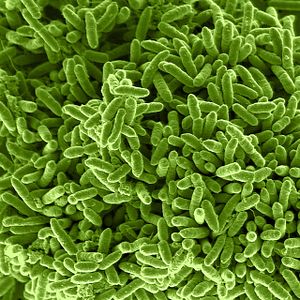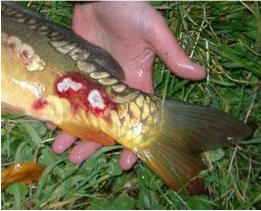Shewanella putrefaciens
Introduction
Shewanella putrefaciens is a bacteria that is found mainly in marine environments. It is a gram negative bacteria, meaning it does not dye during gram staining, which usually indicates a stronger antibiotic resistance. It is also a facultative anaerobe, meaning it can undergo aerobic respiration when oxygen is present, and can reduce iron and magnesium metabolically. Because of this Shewanella putrefaciens can reduce Uranium and create uranium deposits. Sheweanella putrefaciens grows quickly on both solid and liquid media and is recognizable for its pink color. Shewanella putrefaciens was first isolated from dairy products in 1931 by Derby and Hammer. It is classified as an Achromobacter and later named by MacDonell and Colwell in 1985.
Effect on Marine Life
Shewanella putrefaciens can be found in freshwater, brackish, and salt water ecosystems. Many healthy marines animals are contaminated with Shewanella putrefaciens only to have it be realized when food caught by seafood industries spoils due to the bacterias presence. In freshwater animals, and in particular fish species of trout, the bacteria has been shown to cause disease. The effect of the bacteria is seen through external lesions and visible bacterial colonies. Fatality from Shewanella Putrefaciens usually only occurs if the fish are already in poor health, under environmental stress or a whole body inner infection occurs that impedes organ function. Most research done on Shewanella putrefaciens in relation to marine life concentrates on the prevention of bacterial outbreaks in fisheries. Much of the problem in prevention comes from Shewanella's tendency to become a contaminant or saprophyte, meaning it is often found living among other bacterial infections on previously damaged organs, as well as the bacteria's ability to survive at extreme low temperatures and respiratory diversity. These things combined make the bacteria hard to detect until after the death of an organism, and hard to kill without the use of antibiotics. Shewanella putrefaciens is also known to cause the rotting smell associated with dead fish because of its production of trimethylamines.
Impact on Humans
Shewanella putrefaciens as a humans pathogen is very rare. If it does effect human health it is typically only seen to show effects in combination eith other bacterial infections such as E.coli, pneumonia, and streptococcus. Infections form Shewanella putrfaciens mainly occur in soft tissue such as skin, intra-abdominal areas, or in the blood.
Shewanella putrefaciens is a main food spoilage bacteria in marine fish, which in turn can effect human health, but also creates a problem for the food industry. It also posses an even larger problem for the food industry because of its ability to form film on the food processing equipment that is mainly made of stainless steal. Studies done by Applied and Environmental Microbiology society looked deeper into this problem and the possibility that Shewanella Putrefaciens colonies on the equipment may be the source of further bacterial pollution while also causing corrosion of the equipment itself. The persistence of Shewanella putrefaciens colonies on the equipment, even after dissenfection, is partially due to the fact that it is a gram negative bacterium that has a higher resistance to antibiotics. The results of this study showed that although disinfection did not have a significant impact on Shewanella putrefaciens growth on the equipment, the presence of the bacteria P. fluorescens did inhibit growth. This is due to the fact Shewanella putrefaciens tends to grow in "microbial communities" where other bacteria is part of the film formed. When P. fluoresens is present in microbial film with Shewanella putrefaciens it outcompetes and limits its growth.
Conclusion
Shewanella putrefaciens is also well known for its use in biotechnology. Shewanella putrefaciens is a metal reducing, facilitate anaerobe and this quality contributes to its ability to be used in biotechnology. It is used as many things from a bioremediate of chlorinated compounds to a radionuclide and a biocatalyst. Its ability to be a biocatalyst and to reduce iron has lead to interesting research done with Shewanella putrefaciens being used in fuel cells. This research is being done at the Korean Institute of Science and Technologyand has shown that Shewanella has the ability to be used in a fuel cell as part of a biosensor for lactate. This means with the presence of Shewanella putrefaciens as a electronon acceptor and metal reducer of iron their was a change of charge detected in the fuel cell when lactate was added. This presence of an electrochemical reaction could mean a lot of things for the use of Shewanella putrefaciens in fuel cells later on. The bacteria has also been shown to derive energy by reducing uranium, manganese, Vanadium, and Technetium.
References
[http://www.ncbi.nlm.nih.gov/pmc/articles/PMC92873/ Bagge, Dorthe, Hjelm, M., and Gram, L. “Shewanella putrefaciens Adhesion and Biofilm Formation on Food Processing Surfaces”. "Applied Environmental Microbiology". 2001. May; Volume 67(5). p. 2319–2325.]
wikipedia
Min, M., Xu, H., Chen, J., and Fayek, M. "Evidence of uranium biomineralization in sandstone-hosted roll-front uranium deposits, northwestern China". "Ore Geology Reviews". 2005. Volume 26 (3–4) p. 198.
Martín-Gil, J, Ramos-Sánchez, M.C., andMartín-Gil F.J. "Shewanella putrefaciens in a fuel-in-water emulsion from the Prestige oil spill". "Antonie Van Leeuwenhoek". 2004. Volume 86 (3). p. 283–5.
College summary
Brink, AJ, Van, Straten, A, Van, and Rensburg, AJ. "Shewanella (Pseudomonas) putrefaciens bacteraemia". "Clin Infect Dis". 1995. Volume 20. p. 1327–1332.
Chen, Y.S., Liu, Y.C., Yen MY, Wang, J.H., Wang, S.R., and Cheng, D.L. "Skin and soft-tissue manifestations of Shewanella putrefaciens infection". "Clin Infect Dis". 1997. Volume 25. p. 225–229.
Edited by [Nora Hamovit], student of Joan Slonczewski for BIOL 116 Information in Living Systems, 2013, Kenyon College.


